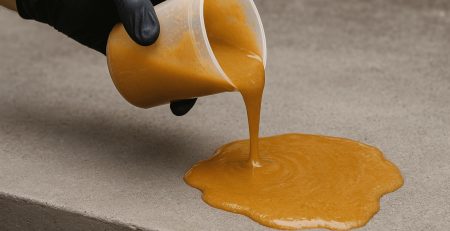When Ordinary Epoxies Fail, This One Thrives.
In environments where hydrochloric acid drips, sulfuric acid vapors, or high-proof alcohols are part of the daily routine, standard coatings don’t last — they crack, peel, or dissolve.
But MR. JO ProtectoKot – CSA was made for exactly such challenges.
A solvent-resistant, high-performance epoxy coating, CSA doesn’t just resist damage — it endures, where other coatings give up.
🔍 What Makes CSA Different?
CSA is a two-component, high-chemical-resistance epoxy with the following superpowers:
- ✅Outstanding resistance to inorganic acids, alcohols, solvents, and caustics
- ⚠️Short pot life (~10 min) — a race against the clock, but worth it
- 🧱Excellent adhesion and film integrity
- 💧 Applied on tanks, ship hulls, solvent pipelines, or chemical process floors
🔥 Fully cured in 2 hours, performs at full strength in 10 days
🧩 Real-World Problems It Solves
Used across chemical industries, pharma, fuels, and coatings, CSA was built to protect against:
- Aggressive acids: sulfuric acid (up to 70%), hydrochloric acid (up to 36%)
- Strong alkalis: sodium hydroxide (up to 30%)
- Solvent loads: ethanol 96%, isopropanol, xylene, premium gasoline
- Harsh cleaning agents or drip zones
- Alcoholic beverage tanks, where food contact + solvent resistance is needed
CSA works where polyester or PU coatings can’t survive. If you’ve had coating failure due to exposure to fuels, spirits, acids, or alkalies, CSA is your go-to fix.
🛠️ Application: Fast, Tough, Unforgiving
Mix Ratio: 100:20 pbw
Pot Life: ~10 minutes
Viscosity at 25°C: ~10,400 mPa·s (brushable high-build)
Recommended Film Thickness: 300–400 μm
Full Cure: ~2 hrs dust-dry; 10 days for full immersion resistance
Application: Brush or roller on sandblasted steel or primed concrete
⚠️ CSA requires precision and preparation — no room for delays once mixed.
🧪 Chemical Resistance at a Glance
| Chemical | Resistance |
| Hydrochloric Acid (10–36%) | ✅ Resistant |
| Sulfuric Acid (10–70%) | ✅ Resistant |
| Ethanol (50–96%) | ✅ Resistant |
| Ammonia (10–25%) | ✅ Resistant |
| Sodium Hydroxide (10–30%) | ✅ Resistant |
| Xylene, Toluene, Heptane | ✅ Resistant |
| Skydrol (Hydraulic Fluid) | ✅ Resistant |
| Trichloroethylene | ✅ Resistant |
| Methanol, MEK, Acetone | ⚠️ Limited to Attacked |
| Lactic & Acetic Acids (10%) | ⚠️ Attacked |
| Isocyanate Blends | ⚠️ Limited |
Tested at 20–22°C immersion for 7+ days at 300–400μm film thickness on sandblasted steel.

🏭 Where Is CSA Used?
ProtectoKot-CSA is the trusted choice in:
- 🧪Chemical Process Plants
- 🚢Marine Tanks and Ship Compartments
- 🛢️Fuel & Solvent Holding Tanks
- 🧬Pharmaceutical Manufacturing
- 🥃Distilleries & Food Plants (Alcohol tanks)
- ⚗️Chemical Dosing Pipelines
- 🧴Drip Pans, Secondary Containment Bunds
- 🏭Heavy Industrial Floors
“We specified CSA in a distillery where ethanol fumes had ruined the previous coating in under six months. CSA is holding up brilliantly.”
— Consultant, Industrial Coating Contractor, Gujarat

🔗 Paired Products
To ensure CSA performs at its peak:
- Primer Recommendations:
- For concrete: MR. JO Primer-MVC or LVC
- For steel: Sandblasting + MR. JO Primer-UPS
- CSA is often used standalone; additional topcoat not required due to chemical load
- Topcoat Compatibility:
- Optional Screed Use:
CSA can be used to create chemical-resistant screeds by adding quartz fillers (3:1 ratio suggested) for bund linings and trenches
⚠️ Application Notes
- Apply in controlled temperature (20–30°C), avoiding humidity
- Ensure mixing is complete — CSA is sensitive to improper ratios
- Due to its fast gel time, plan batch sizes accordingly
Surfaces must be dry, clean, and roughened before application
🧪 Final Word: Why CSA?
If you’re facing:
- Acid tanks that peel coatings
- Fuel lines that dissolve paints
- Solvent vapor zones corroding floors
- High-proof alcohol tanks needing food-safe coating
…MR. JO ProtectoKot-CSA is engineered for exactly that.
✔️ Fast curing
✔️Unbeatable chemical resistance
✔️High-build film in one go
✔️Trusted in mission-critical sectors





Leave a Reply